In recent times, the largest cities in Africa have become quite awe-inspiring even to the most traveled globe-trotting tourist. This is mainly because they have begun to tap into the tech-savviness of the contemporary world and have gone ahead to revolutionize the outlook of their environs and working systems. These big African cities now play hosts to several architectural masterpieces, impressive creations of civil engineering, and complex road networks. Yet, some of these cities still have several ancient architectural monuments that keep pulling the rest of the world to them.
Whether by population or by the size of its landmass, the African continent is a big one. As a matter of fact, Africa is the world’s second-largest and second-most-populous continent after Asia, and its most populous cities are homes to millions of people working to better their lives. Impressively, the ten of the largest cities in Africa have become testaments to African excellence, and with the ongoing advancements taking place in these cities, it’s not hard to see why.
1. Lagos, Nigeria
Population: 21.3 million
Size: 1,171.28 square kilometers
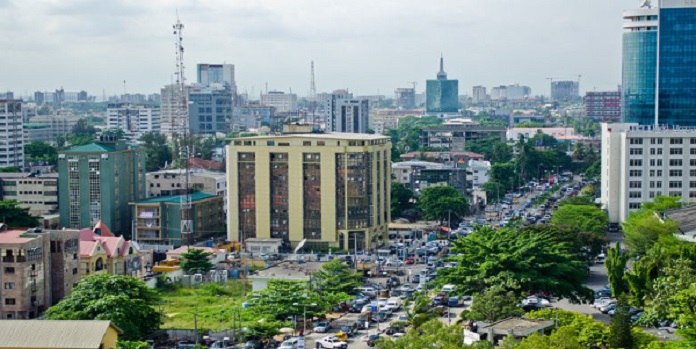
- Founded: Lagos was founded by the Awori subgroup of the Yoruba tribe in the 15th century.
- Time zone: GMT +1
- Weather/Temperature Average: 23 -33 degrees Celcius. Usually, the warmest month in Lagos which brings with it the highest average high temperature is February (33.1°C). However, the months that usher in the lowest average high temperature in Lagos are July and August (28.1°C). Additionally, records show that the month with the highest average low temperature is March (23.8°C).
- Area Code: 010
- Demonym: Lagosian
The city of Lagos is an incredibly robust place constantly bustling with life; with its 21.3 million people, it is the most populous city in Nigeria and the African continent as a whole. It is also, in fact, a major financial center for all of Africa has the fourth-highest GDP in the continent. It is also reported to be one of the fastest-growing cities in the world. To lend some credence to its robustness, records show that Lagos currently houses one of the largest and busiest seaports in entire Africa.
Many Nigerians and other Africans consider Lagos as the go-to place to achieve success in business and career choices and the city has succeeded in producing megastars in entertainment and sports, and moguls in business.
Fun Fact: The city of Lagos has the current tallest building in West Africa, the NECOM House tower, which stands about 525 ft and is a 32-story building.
2. Kinshasa, Democratic Republic of the Congo
Population: 14.34 million people
Size: 9,965 square kilometers
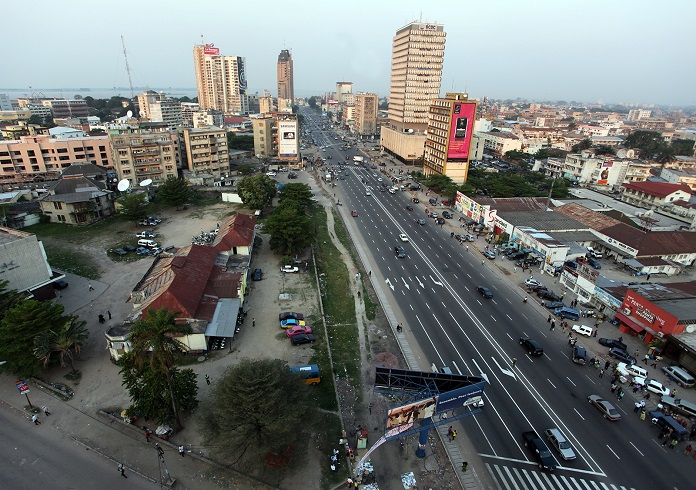
- Founded: Kinshasa was founded by the colonial administrator, Henry Morton Stanley in 1881.
- Time zone: GMT +1
- Weather/Temperature Average: 10-38.9 degrees Celcius. Kinshasa usually records the highest temperature in March (38.9°C) and records the lowest recorded temperature in July (10°C).
- Area Code: 243 + 9
- Demonym: Kinois or Kinshasans.
Kinshasa, which is the capital and the largest city of the Democratic Republic of the Congo, started as a fishing and trading village but has grown into a megacity. In fact, Kinshasa is now the world’s largest Francophone urban area, beating Paris to that title (by population). Today, the city boasts of massive structures and is the third-largest urban area after Cairo and Lagos.
Fun fact: It is interesting to know that Kinshasa actually faces Brazzaville, the capital of the neighboring Republic of the Congo. This makes Kinshasa and Brazzaville the world’s second-closest pair of capital cities after Rome and Vatican City.
3. Cairo, Egypt
Population: 9.5 million
Size: 3,085 square kilometers

- Founded: Cairo was found by the Fatimid dynasty in 969 AD.
- Time zone: GMT +2
- Weather/Temperature Average: 18.9 – 34.7 degrees Celcius. The warmest month in Cairo is usually in July (34.7°C). But, the month with the lowest average high temperature is usually January (18.9°C).
- Area Code: (+20) 2
- Demonym: Cairene
Cairo, the capital and largest city in Egypt, is one of the most developed cities in Africa and is actually to be considered a World City with a “Beta +” classification. The city boasts of a metro system that ranks amongst the fifteen busiest in the world. It is also reported to be the largest city in the Arab world. Beyond this, Cairo is also home to many culturally significant buildings such as the Bayt Al-Suhaymi and the Citadel of Cairo, among others.
As a majorly Muslim city, Cairo is respected for its abundance of Islamic architecture and has even been titled “the city of a thousand minarets” because of that.
Fun fact: Cairo has the oldest and largest film and music industries in the Arab world.
4. Giza, Egypt
Population: 8.8 million
Size: 1,580 square kilometers

- Founded: Giza was founded by ancient Pharaohs in 642 AD.
- Time zone: GMT +2
- Weather/Temperature Average: 5- 44.4 degrees Celcius. The highest recorded temperature in Giza is usually recorded in May – 44.4°C; while the lowest recorded temperature in Giza is 5°C, which is often recorded in January.
- Area Code: (+20) 2
- Demonym: Gizan, Gizanne
Giza is the third-largest city in Egypt and is also one of the most visited places by tourists. This is because it is home to some of the most impressive ancient monuments in the world. Some of the ancients monuments present in Giza today include the Great Sphinx, the Great Pyramid of Giza, a complex of sacred structures and ancient Egyptian royal mortuary, and many more. Giza is undoubtedly rich with culture and history – a legacy that has always been a source of pride to its citizens. Interestingly, the city of Giza has always been considered to be a focal point in Egypt’s history.
Fun fact: The city of Giza hosts the first zoo on the entire African continent.
5. Johannesburg, South Africa
Population: 5.64 million
Size: 1,645 square kilometers
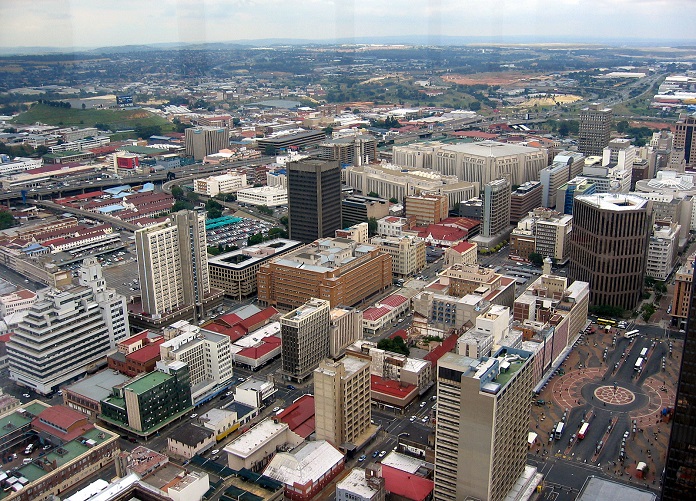
- Founded: Johannesburg was founded in 1886 and was named after Christiaan Johannes Joubert and Johannes Rissik, two land surveyors who combined the name they shared and then added ‘burg’ to it to form the city’s name.
- Time zone: GMT +2
- Weather/Temperature Average: 4.1 – 25.6 degrees Celcius. The warmest month in Johannesburg (with the highest average high temperature) in January when the temperature is usually at 25.6°C. The coldest months in Johannesburg (with the lowest average low temperature) are June and July when the temperature drops to 4.1°C.
- Area Code: 010 and 011
- Demonym: Johannesburger
Johannesburg, which is also informally known as Joburg, is the largest city in South Africa and is one of the most intriguing cities in Africa as a whole. The famed city has some of the tallest structures on the continent and is one of the most developed urban areas in Africa.
Johannesburg is classified as a megacity and is, in fact, considered to be one of the 50 largest urban areas in the world. It is also the center of large-scale gold and diamond trade and has some of the largest mines in Africa.
Fun fact: Johannesurg has the busiest airport in Africa, the Tambo airport, which receives over 21 million people annually.
6. Dar es Salaam, Tanzania
Population: 5.5 million
Size: 1,590 square kilometers
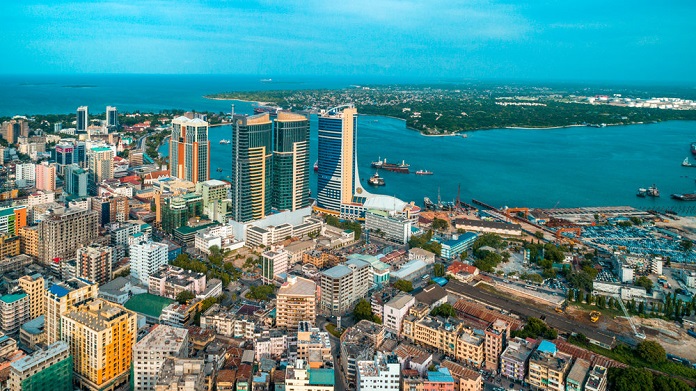
- Founded: Dar es Salaam was founded by the Majid bin Sayyid, the Sultan of Zanzibar, in 1866.
- Time zone: GMT +3
- Weather/Temperature Average: 25 -31 degrees Celcius. Dar es Salaam records its warmest months in March and December when the temperature usually rises to 31°C. It records its coldest months in January and February when the temperature drops to 25°C.
- Area Code: 022
- Demonym: Not known
Dar es Salaam, which is an Arabic phrase meaning “haven of peace,” was the former capital city of Tanzania and is actually the largest city in Tanzania and East Africa at the moment. It is also considered to be one of the fastest-growing cities in the world.
Though Dar es Salaam is no longer the capital city of Tanzania, the city is now more highly thought of than the capital city of Dodoma. It is also the leading financial center in the country. Dar es Salaam has also become the most prominent city in fashion, music, media, music, film and television, and arts in general in Tanzania. It has the highest concentrations of trade and other services, and manufacturing in Tanzania as well. Being a thriving city, it is easy to see how Dar es Salaam has become a prime destination for tourists and world travelers.
Fun fact: Dar es Salaam is the world’s largest and most populous Swahili-speaking city.
7. Alexandria, Egypt
Population: 5.2 million
Size: 2,679 square kilometers

- Founder: Alexandria was founded by Alexander the Great in 331 BC.
- Time zone: GMT +2
- Weather/Temperature Average: 2.8-42.2 degrees Celcius. Alexandria usually records its highest temperatures in May when the temperature rises to 42.2°C. The city usually records its lowest temperature in January when the temperature drops to 2.8°C.
- Area Code: (+20) 3
- Demonym: Alexandrine
Alexandria, a major economic center in Egypt, is the second-largest city in Egypt and is also one of its important industrial centres as well as one of the country’s most popular tourist destinations. The city is of great historical value especially because it was the intellectual and cultural center of the ancient Mediterranean world. It is also home to the Lighthouse of Alexandria – one of the seven wonders of the world.
Fun fact: Alexandria was once the largest city in the ancient world before being it was overtaken by Rome.
8. Abidjan, Cote d’Ivoire
Population: 4.9 million
Size: 2,119 square kilometers
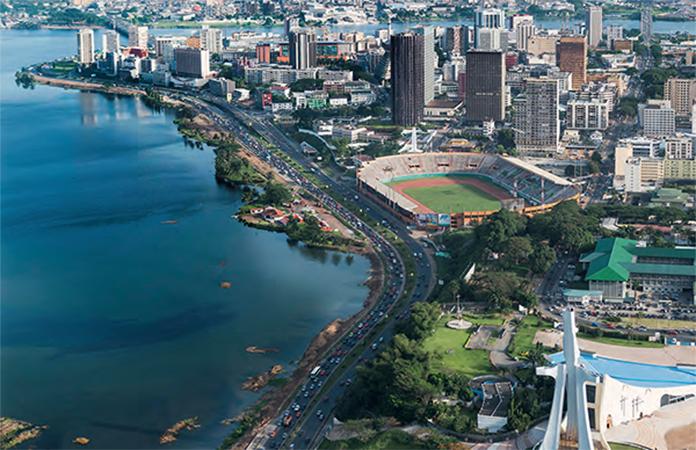
- Founder: Abidjan was founded in 1898 by French colonists.
- Time zone: GMT +0
- Weather/Temperature Average: 24 -31 degrees Celcius.
Abidjan’s warmest month is April when the temperature usually rises to 31.2°C. March, and occasionally April, are the months with the highest average low temperature as the temperature drops to 24.9°C.
- Area Code: +225
- Demonym: Abidjanais
Abidjan, which happens to be the economic capital of Côte d’Ivoire, is a highly developed city which is distinguished by an impressively high level of industrialization and urbanization. It is also one of the most populous French-speaking cities in Africa. Abidjan is not the political capital of Cote d’Ivoire (Yamoussoukro is the capital), however, because of the city’s impressive growth and urbanization, most of the country’s political institutions and even foreign embassies are now located in Abidjan.
Abidjan also has a significant artistic population and as a result, is home to many arts and cultural festivals.
Fun fact: Abidjan is the third-largest French-speaking city in the world
9. Nairobi, Kenya
Population: 4.7 million
Size: 696 square kilometers

- Founded: Nairobi was founded in 1899 by the colonial authorities in British East Africa.
- Time zone: GMT +3
- Weather/Temperature Average: 4.4-35 degrees Celcius. Nairobi usually records its highest temperature in March when the temperature rises to (35°C). The city usually records its lowest temperature in August when the temperature drops to 4.4°C.
- Area Code: 020
- Demonym: Nairobian
The name Nairobi comes from Enkare Nairobi, a Maasai phrase which means “cool water”. Cool water here is a direct reference to the Nairobi River which flows through the city. Over the years, the city has grown to become an established hub for business and now has one of the largest security exchanges in Africa. Nairobi, which the largest city in Kenya, also plays host to more than 100 major international companies and organizations as well as thousands of local Kenyan businesses. The Kenyan city is also a notably iconic tourist hub and attracts more than one million tourists annually
Fun fact: Nairobi is also referred to as the “Green City in the Sun.”
10. Casablanca, Morocco
Population: 4.3 million
Size: 220 square kilometers
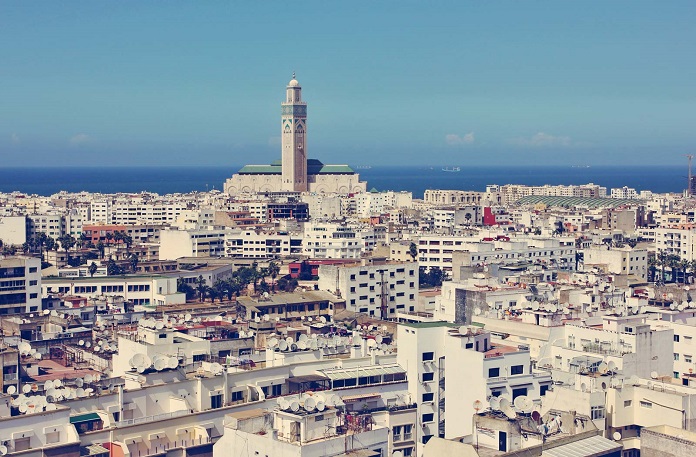
- Founded: Casablanca was founded and settled by Berbers by the seventh century BC.
- Time zone: GMT +1
- Weather/Temperature Average: 0-40 degrees Celcius. Casablanca usually records its highest temperature in September when the temperature rises to 40.6°C. It usually records its lowest temperature in January when the temperature can drop to 0°C.
- Area Code: 22
- Demonym: Casawi, Bidawi, Baydawi, Casablancais
Casablanca is the largest city in Morocco and is also the largest city in Northwest Africa. The city has grown to become one of the largest financial centers in Africa and is the authentic economic and business center of Morocco even though it is not the country’s political capital.
Fun fact: The city of Casablanca originally was not called Casablanca; it was originally called Anfa. The name was later changed to Casa Branca by the Portuguese who took control of the city in the 15th century AD. The current name came about when the Portuguese fell under Spanish control.